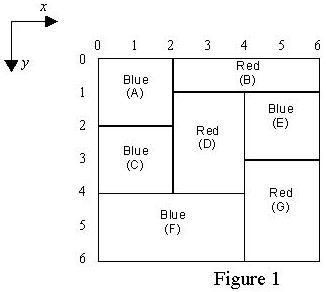Painting A Board
| Time Limit: 1000MS | Memory Limit: 10000K | |
| Total Submissions: 3642 | Accepted: 1808 |
Description
The CE digital company has built an Automatic Painting Machine (APM) to paint a flat board fully covered by adjacent non-overlapping rectangles of different sizes each with a predefined color.

To color the board, the APM has access to a set of brushes. Each brush has a distinct color C. The APM picks one brush with color C and paints all possible rectangles having predefined color C with the following restrictions:
To avoid leaking the paints and mixing colors, a rectangle can only be painted if all rectangles immediately above it have already been painted. For example rectangle labeled F in Figure 1 is painted only after rectangles C and D are painted. Note that each rectangle must be painted at once, i.e. partial painting of one rectangle is not allowed.
You are to write a program for APM to paint a given board so that the number of brush pick-ups is minimum. Notice that if one brush is picked up more than once, all pick-ups are counted.

To color the board, the APM has access to a set of brushes. Each brush has a distinct color C. The APM picks one brush with color C and paints all possible rectangles having predefined color C with the following restrictions:
To avoid leaking the paints and mixing colors, a rectangle can only be painted if all rectangles immediately above it have already been painted. For example rectangle labeled F in Figure 1 is painted only after rectangles C and D are painted. Note that each rectangle must be painted at once, i.e. partial painting of one rectangle is not allowed.
You are to write a program for APM to paint a given board so that the number of brush pick-ups is minimum. Notice that if one brush is picked up more than once, all pick-ups are counted.
Input
The first line of the input file contains an integer M which is the number of test cases to solve (1 <= M <= 10). For each test case, the first line contains an integer N, the number of rectangles, followed by N lines describing the rectangles. Each rectangle R is specified by 5 integers in one line: the y and x coordinates of the upper left corner of R, the y and x coordinates of the lower right corner of R, followed by the color-code of R.
Note that:
Note that:
- Color-code is an integer in the range of 1 .. 20.
- Upper left corner of the board coordinates is always (0,0).
- Coordinates are in the range of 0 .. 99.
- N is in the range of 1..15.
Output
One line for each test case showing the minimum number of brush pick-ups.
Sample Input
1 7 0 0 2 2 1 0 2 1 6 2 2 0 4 2 1 1 2 4 4 2 1 4 3 6 1 4 0 6 4 1 3 4 6 6 2
Sample Output
3
Source
大致题意:
墙上有一面黑板,现划分为多个矩形,每个矩形都要涂上一种预设颜色C。
由于涂色时,颜料会向下流,为了避免处于下方的矩形的颜色与上方流下来的颜料发生混合,要求在对矩形i着色时,处于矩形i上方直接相邻位置的全部矩形都必须已填涂颜色。
在填涂颜色a时,若预设颜色为a的矩形均已着色,或暂时不符合着色要求,则更换新刷子,填涂颜色b。
注意:
1、 当对矩形i涂色后,发现矩形i下方的矩形j的预设颜色与矩形i一致,且矩形j上方的全部矩形均已涂色,那么j符合填涂条件,可以用 填涂i的刷子对j填涂,而不必更换新刷子。
2、 若颜色a在之前填涂过,后来填涂了颜色b,现在要重新填涂颜色a,还是要启用新刷子,不能使用之前用于填涂颜色a的刷子。
3、 若颜色a在刚才填涂过,现在要继续填涂颜色a,则无需更换新刷子。
4、 矩形着色不能只着色一部分,当确认对矩形i着色后,矩形i的整个区域将被着色。
首先要注意输入数据,每个矩形信息的输入顺序是 y x y x c,而不是 x y x y c
若弄反了x y坐标怎样也不会AC的.....
解题思路:
1. 染色问题. 先将图建立起来. 将当前小矩阵编号为i, 与其相邻的或则在上面的矩阵链接起来.(做标记)
2. 深搜解决. dfs(int nowlen,int ans,int color)
nowlen: 小矩阵已经染色的数目, ans: 当前使用画刷的次数. color: 当前画刷的颜色.
#include<cstdio> #include<cstring> #include<iostream> using namespace std; #define inf 0x3f3f3f3f #define N 20 struct node{ int x1,y1,x2,y2,color; }e[N]; int map[N][N],deg[N],vis[N]; int result,n; void read_graph(){ for(int i=1;i<=n;i++) for(int j=1;j<=n;j++) if(e[i].y2==e[j].y1&&(e[j].x1<=e[i].x2&&e[i].x1<=e[j].x2)) deg[j]++,map[i][j]=1; } void dfs(int nowlen,int ans,int color){ if(ans>result) return ; if(nowlen==n){ result=ans;return ; } for(int i=1;i<=n;i++){ if(!vis[i]&&!deg[i]){ vis[i]=1; for(int j=1;j<=n;j++) if(map[i][j]) deg[j]--; if(e[i].color==color) dfs(nowlen+1,ans,color); else dfs(nowlen+1,ans+1,e[i].color); vis[i]=0; for(int j=1;j<=n;j++) if(map[i][j]) deg[j]++; } } } int main(){ int t; scanf("%d",&t); while(t--){ memset(map,0,sizeof map); memset(deg,0,sizeof deg); memset(vis,0,sizeof vis); scanf("%d",&n); for(int i=1;i<=n;i++) scanf("%d%d%d%d%d",&e[i].y1,&e[i].x1,&e[i].y2,&e[i].x2,&e[i].color); result=inf; read_graph(); dfs(0,0,0); printf("%d ",result); } return 0; }